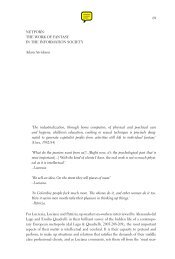Nakamura, Digitizing Race, Introduction, chapter 5, Epilogue
Nakamura, Digitizing Race, Introduction, chapter 5, Epilogue
Nakamura, Digitizing Race, Introduction, chapter 5, Epilogue
You also want an ePaper? Increase the reach of your titles
YUMPU automatically turns print PDFs into web optimized ePapers that Google loves.
170 Avatars and the Visual Culture of Reproduction<br />
considering the rigors of frequent transfers and relocations, especially during<br />
wartime. Younger and less educated women, also newcomers to the Web,<br />
may also find personal “live” testimonials from “real” mothers less alienating<br />
and more reassuring than medical discourse and statistics.<br />
Beyond this, women’s creation of digital signatures enables genuine resistance<br />
to institutional forms of identity management that only continue<br />
to proliferate in daily life. While the seemingly free spaces of composable<br />
identities evident in build-your-own avatar games like MMORPGs continue<br />
to instantiate stereotyped images of women, 64 as Rodowick observes,<br />
“there is still an unequal division of power in the data images that count—<br />
for access to credit, medical insurance, voting and residency rights, ownership<br />
of property, and so forth—[and they are] still culled, collated, and controlled<br />
by a few large corporations and marketing organizations.” 65 What<br />
are the “data images that count,” the avatars that matter, in relation to<br />
women’s reproductive labor online? While pregnancy bulletin boards may<br />
at times affirm normative domestic behavior in terms of pregnancy and child<br />
rearing, the digital signatures on several pregnancy Web sites are evidence<br />
of eclectic digital production that reflects the reality of reproductive labor<br />
and its attendant losses.<br />
Women’s production of digital signatures not only re-embodies themselves<br />
as pregnant subjects but also visualizes holistic visions of family that<br />
embody the paradox of pregnant women’s empowerment and invisibility.<br />
While women who are on the Internet are empowered in a sense, certainly<br />
in relation to their sisters in other parts of the world where access is extremely<br />
scarce for any gender, they are still subject to the regulation of images of<br />
“proper” pregnancies and visual cultures. The gendered and classed nature<br />
of their signatures, as well as their mode of arrangement and visual ranking,<br />
which includes pets, political affiliations, and displays of communal belonging<br />
with other members of the online community, shows the development<br />
of a digital vernacular modernism. Pregnant women represent themselves<br />
exuberantly in the form of their digital avatars, and this energy and joy in<br />
self-representation take on all the more significance in a dataveillant society<br />
that continues to regulate pregnancy through imaging technologies. In<br />
representing themselves and their babies, pregnancies, babies yet to be, and<br />
lost children, women graphically embody themselves as dual subjects of<br />
interactivity in digital visual culture, thus publicizing bodies and lives previously<br />
unrepresented by the women living them.





